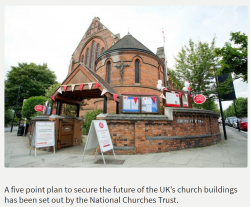 A five point plan to secure the future of the UK’s church buildings has been set out by the National Churches Trust as follows:
A five point plan to secure the future of the UK’s church buildings has been set out by the National Churches Trust as follows:
- Prioritise the maintenance of church buildings.
- Make more churches centres for the community.
- Put churches firmly on the visitor and tourist map.
- Create a one-stop shop for churches applying for funding for repairs and maintenance.
- Open church buildings every day.
The National Churches Trust writes:
The main features of the National Churches Trust’s plan, published in its 2016 – 2017 Annual Review on 19 July 2017, are:
1. Prioritise the maintenance of church buildings.
It is often more cost-effective to look after historic churches through regular maintenance rather than having to undertake often expensive structural repairs because the condition of a building has been allowed to deteriorate.
The funding paradigm should therefore move away from repair and replacement to maintenance and conservation.
New ways should also be found to help the volunteers who look after church buildings to keep them in good repair. The National Churches Trust’s ‘MaintenanceBooker’ website, launched in February 2017, shows how new technology can make it easier to get professional help to maintain church buildings.
2. Make more churches centres for the community.
More churches need modern facilities, such as toilets, kitchens and heating. Modern facilities mean that church buildings can be used as venues for the arts, leisure, social action and other community activities and can host facilities such as post offices and libraries.
The use of church buildings as ‘community hubs’ has the strong support of the public. 83% of British adults think that churches, chapels and meeting houses play an important role for society as they provide a space in which community activities can take place, according to the National Churches Trust’s December 2016 ComRes opinion poll on church heritage.
3. Put churches firmly on the visitor and tourist map.
Churches, chapels and meeting houses are treasure houses of heritage and history and much more should be done to help churches attract visitors. As well as bringing new people through the doors, attracting visitors brings with it additional income through donations and gift purchases.
The National Churches Trust’s ExploreChurches website, launched in November 2016 and developed in close co-operation with partners in the tourism, heritage and church sectors, provides the UK with a high quality website for church visitors and tourism.
4. Create a one-stop shop for churches applying for funding for repairs and maintenance.
The UK’s churches will always require funding from a variety of sources to pay for repairs, maintenance and new facilities. But churches seeking funding have to navigate a complex web of grant-giving trusts, foundations and heritage organisations to access the money they need.
The church heritage sector should streamline the grant application process, possibly through creating a funding portal. This would allow churches to submit one application to reach as many potential funders as possible.
5. Open church buildings every day.
Church buildings need to be open every day so the public can enjoy their beauty, history and sense of prayerfulness.
There is still a widespread view that churches need to be kept locked to prevent theft or vandalism. But an open church can often be safer as the local community then becomes more engaged with the building.
- National Churches Trust grants programme
2017 sees the 10th anniversary of the National Churches Trust, which supports church and chapel buildings of the main Christian denominations throughout the UK. It was created to take forward the work of the Historic Churches Preservation Trust, founded in 1953. Since its formation in 2007 the Trust has provided more than 1,600 grants worth over £15 million to help the UK’s Christian places of worship. A photo gallery at the bottom of this web-page shows some of the churches and chapels that have been helped by the National Churches Trust since 2007.
Luke March, Chairman of the National Churches Trust, said: ‘Many of the UK’s churches and chapels face mounting repair bills. However, this year the Heritage Lottery Fund (HLF) has announced changes to the way it awards grants to places of worship which means that for the first time since 1977, there will be no ring-fenced public money available for church repairs. It is vital that the HLF’s move to make churches compete with the wider heritage sector for funding does not result in a significant loss of grants for urgent structural repairs. The National Churches Trust will work with churches, partners and the HLF to make sure that small churches and chapels, those serving rural communities and those belonging to denominations which find it hard to introduce community use for theological reasons, are not disadvantaged by any changes. The UK’s 42,000 churches, chapels and meeting houses are at the heart of communities in cities, towns and villages. They are a unique combination of architecture, history and faith and a vital part of our heritage. In England, 45% of all Grade I listed buildings are cathedrals and churches.’
‘Our five point plan, which we will develop in partnership with those involved in looking after church buildings at the national, denominational and local level, is designed to help ensure that church buildings play a vital role in the life and well-being of people for many, many years to come. As we move into the second decade of the National Churches Trust, the plan will form part of a new long-term strategy for our work. I welcome the input of anyone involved in looking after or using church buildings.’
Comments can be emailed to: chairman@nationalchurchestrust.org
To obtain a copy of the National Churches Trust’s 2016 – 2017 Annual Review please email info@nationalchurchestrust.org or simply download a copy.
